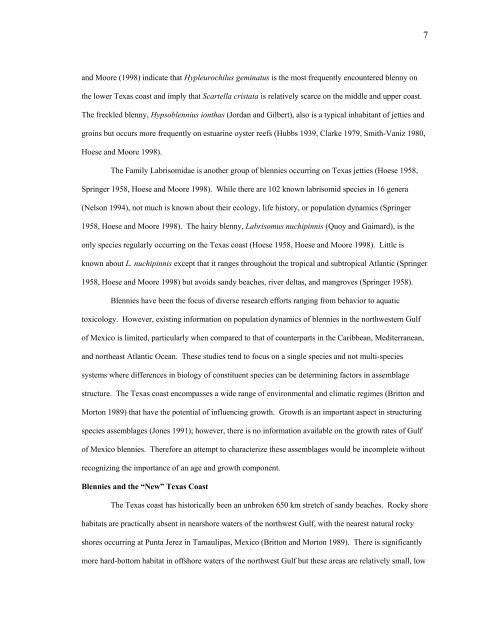Create successful ePaper yourself
Turn your PDF publications into a flip-book with our unique Google optimized e-Paper software.
7<br />
and Moore (1998) indicate that Hypleurochilus geminatus is the most frequently encountered blenny on<br />
the lower Texas coast and imply that <strong>Scartella</strong> <strong>cristata</strong> is relatively scarce on the middle and upper coast.<br />
The freckled blenny, Hypsoblennius ionthas (Jordan and Gilbert), also is a typical inhabitant of jetties and<br />
groins but occurs more frequently on estuarine oyster reefs (Hubbs 1939, Clarke 1979, Smith-Vaniz 1980,<br />
Hoese and Moore 1998).<br />
The Family Labrisomidae is another group of blennies occurring on Texas jetties (Hoese 1958,<br />
Springer 1958, Hoese and Moore 1998). While there are 102 known labrisomid species in 16 genera<br />
(Nelson 1994), not much is known about their ecology, life history, or population dynamics (Springer<br />
1958, Hoese and Moore 1998). The hairy blenny, Labrisomus nuchipinnis (Quoy and Gaimard), is the<br />
only species regularly occurring on the Texas coast (Hoese 1958, Hoese and Moore 1998). Little is<br />
known about L. nuchipinnis except that it ranges throughout the tropical and subtropical Atlantic (Springer<br />
1958, Hoese and Moore 1998) but avoids sandy beaches, river deltas, and mangroves (Springer 1958).<br />
Blennies have been the focus of diverse research efforts ranging from behavior to aquatic<br />
toxicology. However, existing information on population dynamics of blennies in the northwestern Gulf<br />
of Mexico is limited, particularly when compared to that of counterparts in the Caribbean, Mediterranean,<br />
and northeast Atlantic Ocean. These studies tend to focus on a single species and not multi-species<br />
systems where differences in biology of constituent species can be determining factors in assemblage<br />
structure. The Texas coast encompasses a wide range of environmental and climatic regimes (Britton and<br />
Morton 1989) that have the potential of influencing growth. Growth is an important aspect in structuring<br />
species assemblages (Jones 1991); however, there is no information available on the growth rates of Gulf<br />
of Mexico blennies. Therefore an attempt to characterize these assemblages would be incomplete without<br />
recognizing the importance of an age and growth component.<br />
Blennies and the “New” Texas Coast<br />
The Texas coast has historically been an unbroken 650 km stretch of sandy beaches. Rocky shore<br />
habitats are practically absent in nearshore waters of the northwest Gulf, with the nearest natural rocky<br />
shores occurring at Punta Jerez in Tamaulipas, Mexico (Britton and Morton 1989). There is significantly<br />
more hard-bottom habitat in offshore waters of the northwest Gulf but these areas are relatively small, low

















